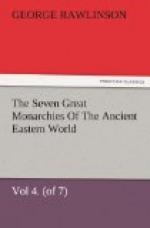Neriglissar, the successful conspirator, was at once acknowledged king. He is probably identical with the “Nergal-shar-ezer, Rab-Mag,” of Jeremiah, who occupied a prominent position among the Babylonian nobles left to press the siege of Jerusalem when Nebuchadnezzar retired to Riblah. The title of “Rab-Mag,” is one that he bears upon his bricks. It is doubtful what exactly his office was; for we have no reason to believe that there were at this time any Magi at Babylon; but it was certainly an ancient and very high dignity of which even kings might be proud. It is remarkable that Neriglissar calls himself the son of Bel-sum-iskun, “king of Babylon”—a monarch whose name does not appear in Ptolemy’s list, but who is probably to be identified with a chieftain so called, who assumed the royal title in the troubles which preceded the fall of the Assyrian Empire.
During his short reign of four years, or rather three years and a few months, Neriglissar had not time to distinguish himself by many exploits. So far as appears, he was at peace with all his neighbors, and employed his time principally in the construction of the Western Palace at Babylon, which was a large building placed at one corner of a fortified inclosure, directly opposite the ancient royal residence, and abutting on the Euphrates. If the account which Diodorus gives of this palace be not a gross exaggeration of the truth, it must have been a magnificent erection, elaborately ornamented with painting and sculpture in the best style of Babylonian art, though in size it may have been inferior to the old residence of the kings on the other side of the river.
Neriglissar reigned from B.C. 559 to B.C. 556, and dying a natural death in the last-named year, left his throne to his son, Laborosoarchod, or Labossoracus. This prince, who was a mere boy, and therefore quite unequal to the task of governing a great empire in critical times, was not allowed to retain the crown many months. Accused by those about him—whether justly or unjustly we cannot say—of giving many indications of a bad disposition, he was deposed and put to death by torture. With him power passed from the House of Nabopolassar, which had held the throne for just seventy years.




